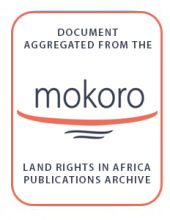Land Library
Welcome to the Land Portal Library. Explore our vast collection of open-access resources (over 74,000) including reports, journal articles, research papers, peer-reviewed publications, legal documents, videos and much more.
/ library resources
Showing items 1 through 9 of 237.The final part of a blog series is a very preliminary reflection on the changes observed over 20 years and some speculation on what the future might hold for the land reform farmers of Masvingo over the next 20 years.
A paper from the Agricultural Policy Research on Africa (APRA) programme in Zimbabwe supported by a DFID grant to IDS;Sussex.
CIFOR undertook a review of Kenya’s legal framework to understand whether legal provisions were sufficient to secure community land and forest rights. Asks how adequate Kenya’s legal framework was in protecting and promoting tenure rights of forest communities.
Biochar is one of the most affordable negative emission technologies (NET) at hand for future large-scale deployment of carbon dioxide removal (CDR), which is typically found essential to stabilizing global temperature rise at relatively low levels.
This study investigates different provisioning services in the peri-urban landscapes of Manila conurbation through a case study of two villages in the Jala-Jala municipality of the Laguna de Bay area in the Philippines.
Companies and governmental agencies are increasingly seeking ways to explore emerging trends and issues that have the potential to shape up their future operational environments. This paper exploits text mining techniques for investigating future signals of the land administration sector.
The large-scale Grain for Green project on the Loess Plateau of China significantly changes the regional landscape pattern, which has a profound impact on runoff and sediment process. The relationship between landscape pattern and runoff and sediment in the Dali River watershed is established.
The planting of sand-binding vegetation in the Qinghai Lake watershed at the northeastern edge of the Qinghai–Tibet Plateau began in 1980. For this paper, we took the desert on the eastern shore of Qinghai Lake as the study area.
In a wave of global conservationism, Ecuador established two large protected areas in its Amazon region in 1979. One of these is the Reserva de Producción Faunística Cuyabeno (RPFC), located in the northeastern corner of the country.


